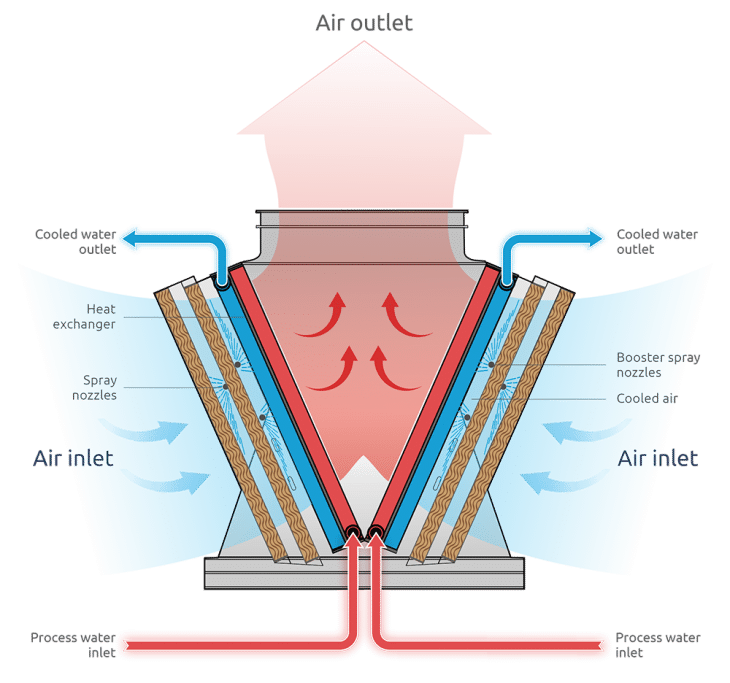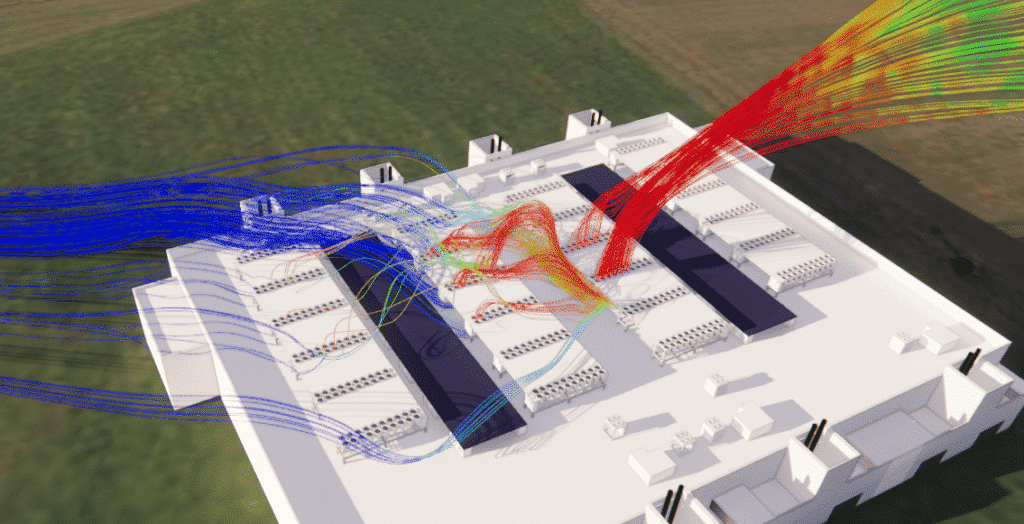External CFD simulation for data center
Accueil » Expertise » Data center » External CFD simulation for data center
EOLIOS takes care of your Data Center
- Study of thermal plumes
- Validation of the maximum air temperature at the equipment inlet
- Selection of equipment adapted to climatic conditions
- Study of critical failure scenarios
- Identification of bypass and recirculation air flows
- Impact study of the generators
- Validation of the installation layout
- Optimization of the placement and control of air handling systems
- Tailor-made solution design
Our projects :
Why perform an external CFD simulation of a data center?
Objective of the numerical simulation
Whether in the courtyard or on the roof, mechanical heat rejection systems such as cooling towers and DRYs share space with emergency generators. A compact, high-density layout of server racks inside the building translates into a compact layout of outdoor equipment. This leads to significant challenges and problems in managing the airflow outside the building.
External CFD studies are used to complete the risk assessment, optimize the design and reduce the energy consumption of the data center.

Schematic diagram of an adiabatic air cooler
Influence of wind and weather on data center performance
The impact of thermal plumes outside the building is difficult to predict because of the different variables that design engineers and architects are not unable to control. These variables include wind speed, air temperature and humidity, wind direction and other activities surrounding the building. However, these phenomena have an impact on the performance of equipment positioned outdoors.
EOLIOS accompanies you in the study of the impact of these problems to ensure an optimal operation in all circumstances, even the most extreme.
Modeling of thermal plumes subjected to wind on a data center roof
Why perform an external CFD simulation of a data center?
Validation of the design in extreme conditions
These simulations provide results that aid data center owners and designers in the decision-making process by determining cost-effective layouts and performance. CFD analysis, when performed prior to finalizing and implementing the design, allows tomitigate the risks associated with design errors, which can lead to the need for major changes and expensive , construction delays see a loss of computing capacity in case of a critical failure during a heat wave.
"Is your data center protected against the failure of its climate systems during a heat wave? "
Systems suitable up to a certain temperature level
Most manufacturer’s equipment documents provide minimum clearance requirements for air conditioning equipment typically positioned on the roof. While this information is provided as a guide, it is expected that designers will consider these parameters in the layout of the machines.
We generally find recommendations from the manufacturer regarding the installation of its equipment: minimum distance between systems, maximum temperature of use…
However, these guidelines do not take into account ambient air conditions, wind speed or the nearby built environment.
The figure below shows how adhering to the manufacturer’s recommended minimum distances can still result in undesirable performance.
A detailed model that adapts to different scenarios
We create a detailed computer model including surrounding buildings, all cooling devices on data center roofs, all exhausts, fresh air intakes and details such as windscreens, louvers and roofs…
We then use this model to study airflow, temperature distribution and water vapor (relative humidity) in several scenarios. These scenarios vary depending on the operational mode (normal, maintenance, emergency) and the weather conditions (high or low temperature, wind speed and direction).
Illustration of the thermal plumes of several data center buildings, during a heat wave, and during an emergency restart of the air conditioning systems
Study of the interaction of rooftop air conditioning systems in relation to wind
The hot air exhausted through the chimney flues is composed of the generator fumes and the air superheated by the heat exchange batteries. These airflows are blown back into the building by the wind, which causes heat to be recirculated through the roof systems.
Due to these conditions, the ambient air temperature range at the inlet to the mechanical air conditioning equipment may be outside the manufacturer’s recommended operating range. These phenomena can lead to a loss of power or even the stopping of certain equipment.
CFD analysis allows us to understand how several systems will interact with each other. The video below shows the impact of the exhaust air (thermal plume) of generators in relation to the air conditioning equipment on the roof.
Define the power losses in extreme conditions
The mutualization of systems, the superposition of server halls, the continuous increase in power of the server racks leads to an extremely high dissipation of calories on the roof. The dissipation surface being constrained by the dimensions of the building, the result is a very high concentration of air conditioning systems on the roof, leading to a significant risk of power losses, or even cascading of systems during extreme climatic conditions.
In very high heat, or during on-site electrical power failure scenarios, overheated air plumes generated by the cooling systems can generate a sharp drop in cooling power, or even a cascading shutdown of the roofing systems. leading to a generalized default on the site.
External data center CFD studies make it possible to study the risks of power losses and to optimize the layout of the cooling systems on the roof.
Study of pollutant releases - Nox from generators
At the same time, it is possible to verify that the fumes (Nox) from the generators are not taken back by the air handling units on the roof, which would lead toair pollution in the offices .
What use is internal CFD simulation for data centers?
Interior CFD modeling is typically used at the design stage for facility sizing analysis. Computer simulation provides information on the relationship between the operation of air conditioning systems and changes in the thermal load of computer equipment. With this information, IT and site personnel can optimize airflow efficiency, remove hot spots and maximize cooling capacity.




